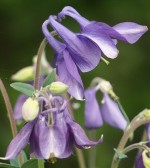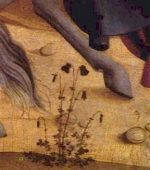
Also called Granny’s bonnet and European crowfoot, this herbaceous perennial is native to woodlands and meadows of Europe. It is a member of the buttercup family, Ranunculaceae, that also includes delphinium, clematis, and monkshood. Plants grow 18-36″ tall and form clumps of thin, branching stems with leaves that have three groups of three leaflets. From late spring to early summer blue to violet flowers appear with 5 spreading petal-like sepals and 5 petals ending with a short hooked spur. Photo Credit Wikipedia
Originally garden columbine was dedicated to Freya the Norse goddess of blessings, love, lust and fertility. One of the plants associated with Freya is common columbine which was valued for its use as an aphrodisiac. As Christianity spread over Europe some of the characteristics of Freya were transferred to the Virgin Mary, including love and the association with common columbine. The three lobed leaves were taken as symbols of the Holy Trinity and the spurs of the flowers (seen as 5 doves) were associated with the Holy Spirit. The common name columbine, is from the Latin word columba meaning dove.

After the annunciation, Mary went to visit her cousin Elizabeth who was pregnant with John the Baptist. One story says that columbine flowers sprang up as Mary went on her trip and the flowers assumed the name of Mary’s Shoes or Mary’s Slippers. A columbine plant can be seen in the painting “Resting on the Flight into Egypt” by Meister von Mondsee (1490-1500) (right). The columbine plant is located in the lower left near the donkeys hind legs and is shown in detail below. Photo Credits Wikipedia

Garden columbine likes organically rich, medium moist, well-drained soil in partial shade and should not be allowed to dry out. Plants are short lived but readily reseed and hybridize. Leaf miners can disfigure the leaves but do little harm in the long run. Other pests include borers and aphids. Plants decline after blooming and can be cut to the ground to encourage new growth. Pink and white hybrids are available. USDA Hardiness Zones 3-8.
The genus name, Aquilegia, comes from the Latin word aquila meaning eagle and perhaps refers to the resemblance of the spurs to the talons of an eagle. The specific epithet, vulgaris, is the Latin word meaning common.